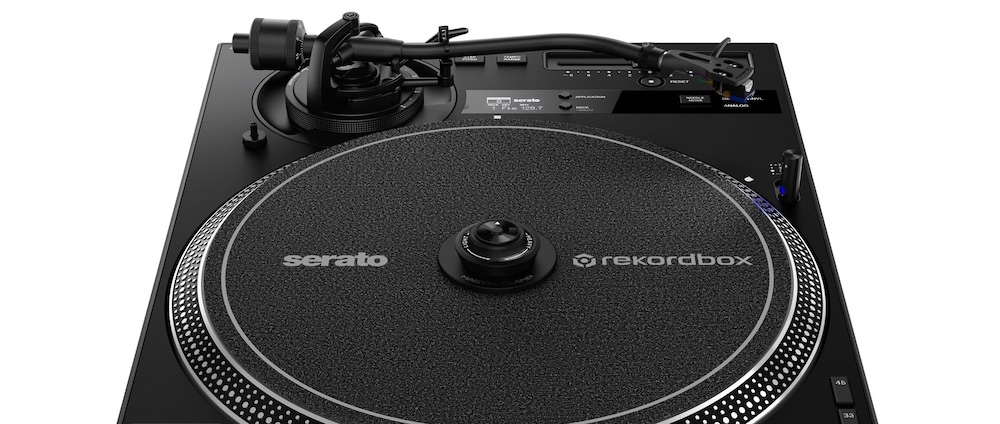The world’s first hybrid analogue/digital turntable, the CRSS12 promises the best of both worlds for vinyl and Serato DJs. Greg Scarth finds out why it could be the best of both worlds for club installations and home DJ setups alike.

The Pioneer PLX-CRSS12 is a unique turntable. Pioneer claim it as a world first, and we’re inclined to agree. We assume that the product name CRSS stands for ‘cross’, given that the turntable is a cross between a conventional analogue deck and a digital vinyl controller. There are lots of differences between the offerings, but the CRSS12 sits somewhere between Pioneer’s PLX-1000 and Rane’s Twelve MKII. You can play records and use the CRSS12 as a turntable, but the main point here is that you can also use it as a controller for digital vinyl software like Serato DJ Pro. The CRSS12 promises to be the best of both worlds, the first ever hybrid controller on the market and one which is designed specifically for people who want to switch back and forth between vinyl and digital as part of a DJ set, all with the hands-on control and feel of a turntable.
So, what is the CRSS12? Essentially it’s a DJ turntable based on the same kind of concept as Pioneer’s PLX1000 deck, with a high-torque, direct-drive motor and S-shaped tonearm. But in addition to the standard analogue functions, it’s also a tonearm-free digital vinyl system controller, allowing you to control software such as Rekordbox or Serato. There’s no getting around the fact that the Rane Twelve is an obvious comparison here. The American brand’s vinyl-style controller is a benchmark for DVS users, but the big difference here is that the Pioneer deck uses any vinyl record as the controller rather than the Twelve’s bespoke control vinyl. The setup is actually broadly similar to the Hercules DJ Control Inpulse T7 which we recently reviewed, using a special spindle which effectively analyses the movement and rotation of the record separately to the movement of the platter. The CRSS12 uses a new Magvel Clamp which locks on to the spindle, offering adjustment of the turntable feel, more of which later.

Assembling the CRSS12 is, unsurprisingly, a cross between hooking up an analogue turntable and a digital controller. After attaching a head shell and cartridge (either the included items or your own preference), the platter is installed. Here’s where things differ slightly from a conventional turntable, as the platter must be screwed onto a central section of the turntable mechanism rather than simply slotting on top. This is in order to provide the control of the two separate elements of the unit, the platter and spindle. With the platter installed, the signal from the stylus is sent out via phono outputs, while a USB connection hooks up to your computer for DVS control. It’s something of a split personality, but it’s easy to understand and no more difficult than hooking up a traditional turntable and controller. It’s also immediately apparent that the setup of the CRSS12 is quite clearly designed with scratch DJs in mind. All the writing on the plinth is orientated so as to be perfect for battle-style setup, with performance pads situated at the bottom left.

For obvious reasons, there are two sides to the performance of the CRSS12. As a conventional turntable, it follows on from the excellent PLX-1000, which is very much a Technics SL1200-inspired approach to the classic DJ deck. Pioneer are keen to point out that the PLX-CRSS12 actually outperforms the PLX-1000 in terms of vinyl playback, before you even consider the digital side of things. At 12.2 kg it’s not quite as heavy as the PLX-1000 and it doesn’t quite match up to the fully analogue option in terms of wow and flutter or signal to noise ratio, but the CRSS12 feels more focussed on scratch DJs than traditional mixing and blending, with great sound and stable performance. The other aspect is, of course, the DVS control side of things, which is where the CRSS12 really comes into its own. It goes without saying that the tonearm-free approach means there’s no need to worry about needles skipping, but what’s most impressive about the CRSS is just how good the vinyl-like control feels. The Magvel Clamp can be adjusted on the fly to change the perceived feel of the vinyl without the need to change slip mats, a great touch which ensures that the CRSS12 offers what must be the most authentic vinyl feel in a skipless, tonearm-free setup. Of course, many of the features of the turntable overlap between the two modes. The CRSS12 has clearly been designed with care and attention given to the needs of turntablists, from the adjustable torque settings (high for quick startup, low for traditional Technics-style feel and mid somewhere in between) to the assignable performance pads (ideal for samples and Hot Cues) and the Motor Off button for slow-down effects.

The CRSS12 isn’t a cheap option, coming in at just under £1,200, but that’s still cheaper than a combination of a PLX-1000 and a Rane Twelve MKII, which is the only real alternative. The major advantage of the CRSS12 – and the thing which might well tempt owners of turntables, DVS timecode vinyl or other controllers take the leap – is how convenient it is to use. Not only is there no need to take up space with both a turntable and a controller, but it simplifies the performance process of switching between vinyl and DVS. We’re certain that this will prove a popular choice for club installations, where the CRSS12 will allow DJs to pick their choice of format without any concerns about switching gear in the booth, but for DJs who need to provide their own gear for gigs or even just for home use, the advantages of this hybrid approach are clear.
Greg Scarth
More info/buy